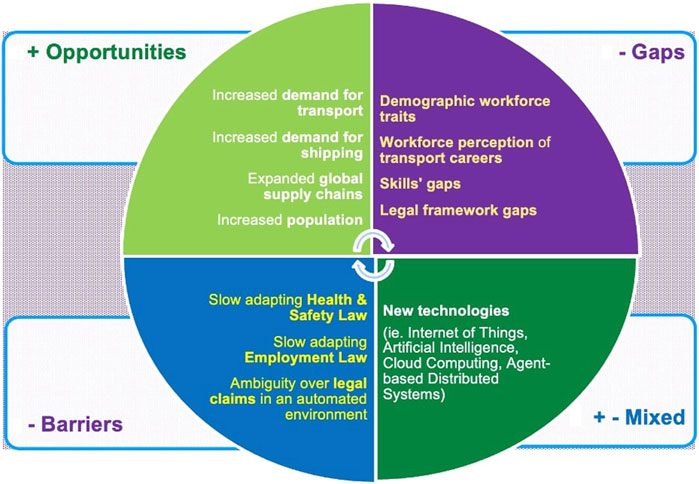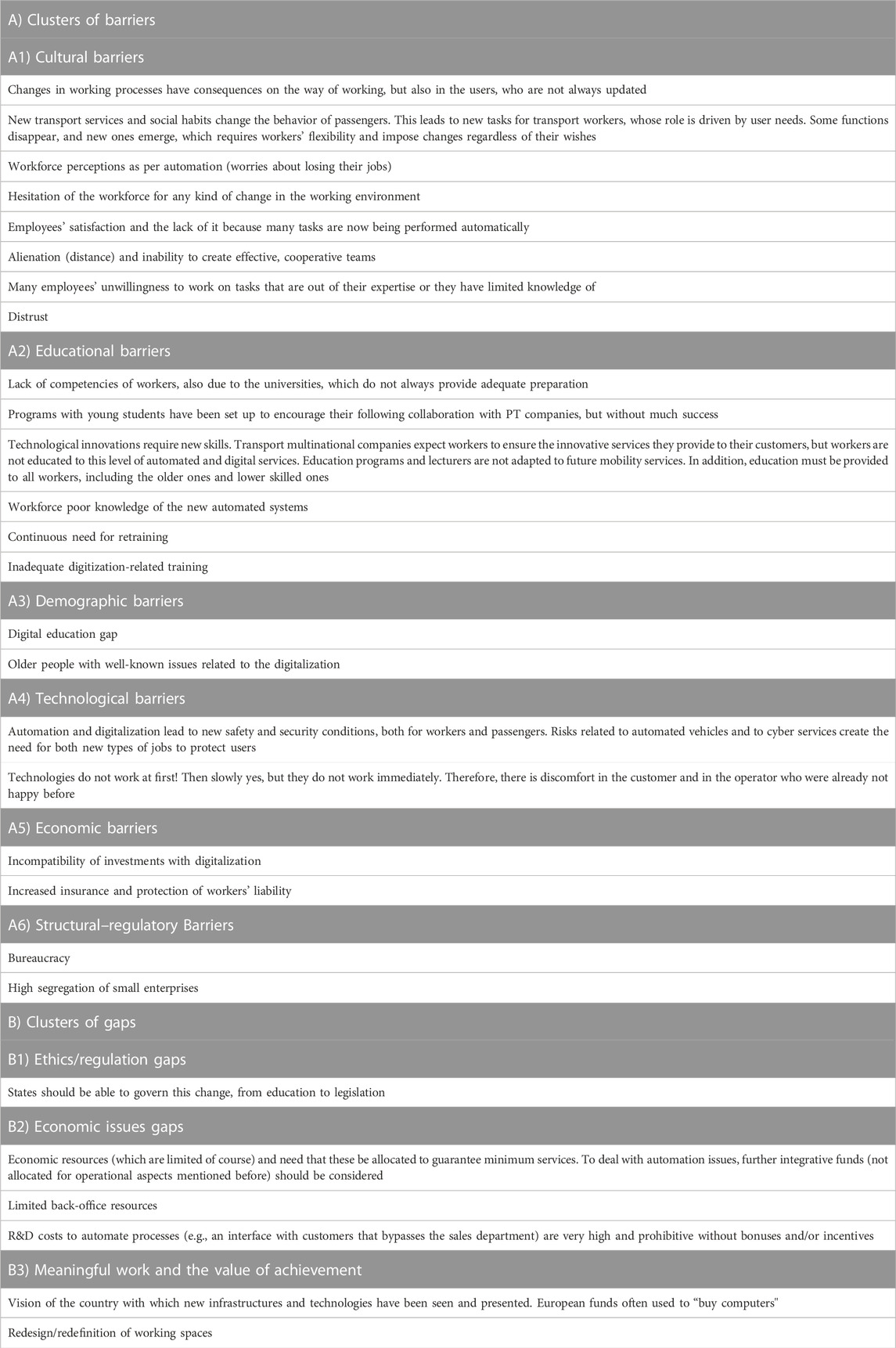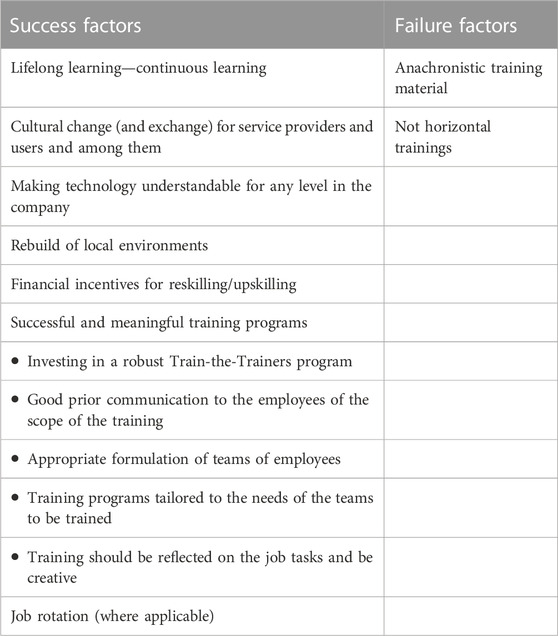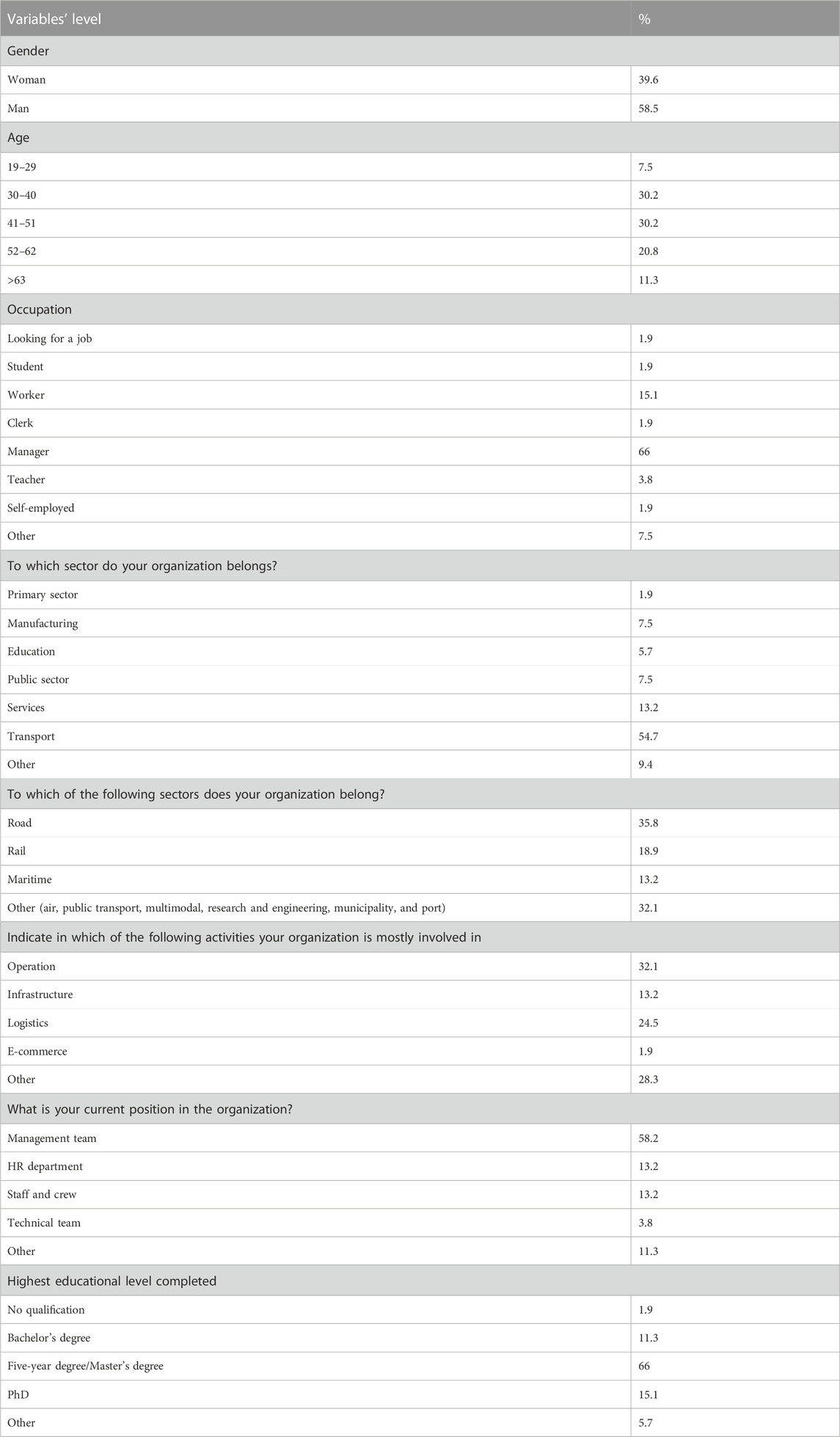- 1Department of Shipping, Trade and Transport, University of the Aegean, Chios, Greece
- 2Interuniversity Department of Regional and Urban Studies and Planning, Politecnico di Torino, Torino, Italy
- 3Department of Civil Engineering, University of West Attica, Egaleo, Greece
Automation in transport and digitalization will affect both transport users and its workforce. Focusing on the latter, this paper aims at analyzing barriers, gaps, opportunities, and success and failure factors of transport automation on the labor force, through the perceptions and contributions of employees and employers, as well as of stakeholders from the private, public, and private–public sectors. In a nutshell, the study aims to understand workforce-related barriers and facilitators associated with the implementation of automation. This has been achieved through input derived from the organization of five focus groups, one poll and one extensive questionnaire survey administered to the participants of the 2nd WE-TRANSFORM EU H2020 funded project Workshop, and to project partners’ stakeholder contacts. The analysis of the results indicated that the transport sector’s automation has been evolving at a different pace per sector. An interesting conclusion is that the challenges do not concern all categories among the workforce in the same way. Challenges related to loss of jobs and related repercussions are bound to affect groups within the workforce, which may be constrained by regulatory age limits, or vulnerable, if in part-time employment without access to retraining, which may be the case of workforce members near retirement age or of women limited due to family obligations to part-time employment. The study’s limitations are related to the size of the sample and how representative it is of all stakeholders in the transport sector, including policymakers, regulators, and unions. Future directions should focus on exploring the long-term impacts of automation on the labor force and identify strategies to mitigate the negative effects on vulnerable groups.
1 Introduction
The aim of the paper is to analyze barriers, gaps, opportunities, and success and failure factors in the context of a state-of-the-art approach implemented for a large European Horizon 2020 project on the impact of automation and digitalization on the workforce in the transport and shipping sectors. The related research is the largest and latest encompassing all transport modes and has used a combination of methodologies in order to assess and cross-check the results of surveys, focus groups, and polls conducted among employees and employers and stakeholders from the private, private–public, and public sectors. This allowed collecting and combining real-time data and perceptions from the fast-changing transport and shipping automation scene focusing on barriers, gaps, skills, and opportunities to allow distinguishing which among these constitute core challenges need to be explored in the future. The objective of the paper is served by the organization of the research through i) five focus groups; ii) a poll—consisting of ten questions administered to the participants of the second EU H2020 funded WE-TRANSFORM project (WET) Workshop which took place in a hybrid format—with parallel physical sessions in Torino, Italy, on 17.11.2021; and iii) a questionnaire administered both to the participants of the Workshop and afterward and to partner stakeholder contacts’ who did not attend the workshop (Polydoropoulou et al., 2023). The design of the research approach followed a thorough review of the relevant literature list which was compiled through the WET artificial intelligence (AI) tool and was supplemented subsequently by the most recent research findings transpiring from the first stages of the project (WE-TRANSFORM, 2022).
The core subject of the research is at the forefront of the academic and social dialog on the transformation of the shipping and transport sectors, but also beyond these. Automation and digitalization are progressively becoming a priority across the transport industry, although not all transport modes follow the two trends at the same pace; although fully autonomous short-haul trains and buses have been in operation for several years and decades, the aviation industry has yet to undergo a significant transformation beyond its millennium business model, except in the realm of ground operations (World Maritime University, 2019; WE-TRANSFORM, 2022). The delay in implementing further automation steps in airborne activities over the past decades can be attributed to safety and evacuation concerns. However, industrial action, particularly in the cockpit crews’ areas, may have also contributed to this delay beyond technical obstacles. Shipping is also taking drastic steps in exploring vessel autonomy for the first time, although it has, for some time now, clearly drafted autonomy stages (IMO, 2022).
The analysis of automation-related barriers, gaps, opportunities, and required skills per mode of transport becomes relevant in the aforementioned context and central in addressing appropriately the impact of automation on the workforce in each transport sector. The recognition that automation presents both challenges and opportunities for the workforce is evident in recent major initiatives at the European level, such as the European Green Deal, Sustainable and Smart Mobility and the New Urban Mobility Framework. These initiatives include specific references to the impact of automation on the workforce and emphasize the need for up/re-skilling workers in the transport sector, which employs over 10 million people in Europe. Automation and digitalization are not unrelated to other transformation trends of sustainability: The initiative of the European Commission “EU Missions: Climate-Neutral and Smart Cities” sets two main aims, namely, a) delivering 100 climate-neutral and smart cities by 2030 and b) ensuring that these cities act as innovation and experimentation hubs to lead all other European cities to climate neutrality by 2050; in these cities, initiatives already implemented encompass automated solutions to previous operational paradigms with a heavy climate-related impact.
Balancing the positive and negative impacts of society, in general, is not a straightforward act and requires the mapping of these impacts, the definition of the nature of the consequences of the workforce, and ways to address and redress any negative outcomes. It is unclear whether the ongoing automation process in the transport and shipping industries will merely continue the existing “business as usual” type of structural change (Vermeulen et al., 2018) within the current economic paradigm that focuses solely on business processes (Dyllick and Muff, 2016). However, this paper does not delve into this discussion of whether automation will signify a paradigm shift toward a more sustainability-compatible business model. It remains, however, critical as the United Nations Sustainable Development Goals (SDGs) (United Nations, 2019)—in which transport is mentioned within multiple goals and indicators, especially in Goal 11—emphasize and promote access to “safe, affordable, accessible and sustainable transport systems”.
The continuous advancements of automatic and fully autonomous vehicles across all modes of transport are impressive enough to create a transitional environment that fosters uncertainty, particularly for the workforce categories most affected. As a result, the case remains open, and the impact of these developments on the future of the transport industry is uncertain. Without barriers and gaps being addressed and opportunities spotted, uncertainty has the potential to generate reactions ranging from decreased attractiveness of the sector to mild friction in terms of industrial action or to severe supply chain disruption in whatever form the latter may erupt. Mapping barriers, gaps, and opportunities is an essential step in order to understand the direction of the impacts of automation on the workforce and also the margins for turning them on their head on the basis of a stakeholder-accepted agenda.
The rest of the paper is structured as follows: Section 2 provides the background concepts for understanding the role of transport workforce in the forthcoming era of automation and digitalization. Section 3 describes the design and communication of the focus groups, polls, and the questionnaire—in the context of the Workshop. Section 4 reports the results. Finally, Section 5 discusses the findings and conclusions.
2 Background
The following sections of the article explore two crucial aspects: the general drivers that will shape the future role of the transport workforce and the specific barriers, gaps, skills, and opportunities that arise from automation on the workforce. Nevertheless, before examining these aspects, the research gap and the contribution of this study to the field are emphasized.
2.1 Research gap and contribution to the field
To fully understand the implications of transport automation on the workforce, it is crucial to identify the barriers, gaps, skills, and opportunities associated with this technological transformation. While automation can offer significant benefits in terms of increased efficiency, safety, and reduced costs, it can also pose challenges to the workforce, particularly those in vulnerable and low-skilled positions. Therefore, a comprehensive analysis of workforce-related issues is essential for designing effective policies and strategies to support the transition toward automation in the transport sector.
This research addresses a critical gap in the transport and shipping industry—the lack of comprehensive analysis on the impact of transport automation on labor force across different transport sectors. While there is existing sporadical literature on the subject focusing on each sector separately (Christidis et al., 2014; Goos, 2018; Chinoracký and Čorejová, 2019; ILO, 2020; Agrawal et al., 2023), this article aims to provide real-time data and perspectives from stakeholders in the industry, using a mixed-method approach of focus groups (FGs), polls, and questionnaires to identify barriers, gaps, skills, opportunities, and success and failure factors of transport automation on the labor force.
Its contribution to the literature is two-fold. First, it provides a comprehensive analysis of the impact of transport automation on the labor force, with a specific focus on identifying barriers, gaps, skills, opportunities, and success and failure factors. Second, it uses a mixed-method approach, which provides a more in-depth and diverse perspective on the impact of transport automation on the labor force. The benefits of using such an approach allow for conducting research on complex and multifaceted topics, such as the one under study. By combining FGs, polls, and questionnaires, researchers gather data from a diverse range of participants, including workers, managers, policymakers, and other stakeholders. This helps providing a more comprehensive and nuanced understanding of the topic. Using multiple methods of data collection can also help researchers validate and corroborate their findings. For example, if the results of the FGs are consistent with the results of the questionnaires, this can increase the confidence in the validity of the findings. Moreover, different methods of data collection provide richer data. For instance, FGs can provide in-depth qualitative data on participants’ experiences, opinions, and attitudes, while polls and questionnaires can provide quantitative data on the prevalence and distribution of the barriers, gaps, skills, opportunities, and success and failure factors. Finally, a mixed-method approach allows researchers to adapt their methods to the research question, as, for example, a more in-depth exploration of participants’ experiences through FGs may be more appropriate, while a broader understanding of the prevalence of aforementioned factors can be easily captured through polls and questionnaires.
2.2 General drivers defining the future role of transport workforce
The interesting dimensions emerging from the review of best practices are that the time of entry into the automation era and the degree to which automation has made inroads into the various transport modes are not synchronous or uniform. For instance, some European ports such as Rotterdam were highly automated already by the mid-1990s, around the time driverless automated trains across European airports had long ceased to be a novelty (Muller, 2007; Keller and Krašna, 2023). Ηοwever, with the start of the 2020s, onboard automation has advanced comparatively little in airline operations and merchant shipping. Within transport modes themselves, there are also differences across segments of the value chain: for instance, airline ground operations across the value chain have been heavily automated, reducing workforce requirements dramatically, while entire—once flourishing—types of services, such as classic travel agencies, have been marginalized.
The foundations for the further expansion of automation in the transport and shipping industries are mainly internal trends originating from business models evolving under competitive pressures (Shiftan and Wilson, 1994). The specific weight and nature of the ensuing impact of automation on the workforce are determined by macrotrends, i.e., demographics and economic growth, globalization, competition, technology, teleworking, and re-shoring, in the context of an increasingly uncertain global environment. Moreover, following the COVID-19 pandemic, the development of some of these trends has accelerated (Tsouros et al., 2021; Salon et al., 2022; Steimle et al., 2022); this has been the case with teleworking and is currently the case with production and procurement re-shoring under the impact of recently severely disrupted supply chains (Deloitte, 2021). With the increasing and also deepening uncertainty in the world environment within which transport and shipping operate (Thanopoulou and Strandenes, 2021), the negative quantitative impact of such drivers on the workforce across both sectors is also predicted to increase and even accelerate as levels of uncertainty keep rising.
On the positive side, the creation of new jobs adapted to the automation phase has been suggested as a primary compensating mechanism for the loss of more manual and repetitive tasks. However, it is important to note that growth of the real sector depends on a number of factors, including demographics, economic growth, and globalization. As per the latter, in recent years, world transport and shipping have seen impressive growth due to increasingly fully globalized supply chains and a rapidly growing world population and GDP. The doubling of the world tonnage from just before the Lehman Brothers crisis to the present decade (UNCTAD, 2007; 2021) well-illustrates this point. Equally impressively—before the COVID-19 shock—the number of airline passengers had doubled between 2010 and 2019 (Maung et al., 2022), while the increase in urban mobility followed demographic trends and the formation of more and ever larger big cities.
As automation is primarily driven by factors internal to the transport and shipping industries, such as competition and technology, it has also been promoted in order to minimize the risk attributed to or generating from the presence of the human factor in these sectors. In shipping, where a crew number is still well over 20 for the average internationally active cargo vessel, as calculated from data in ICS (2022), the aim has been described as follows: “to ensure safe, secure and environmentally sustainable shipping with the relevant legal framework” (UNCTAD, 2021). However, the relation between automation levels and safety increase is not necessarily linear, with human factor causality still found in the—by definition without human crew—area of drones (Ghasri and Maghrebi, 2021). To minimize overall risk along with any negative impacts from automation, investigating barriers and gaps related with the impact of the latter on the workforce, potential remedies to these and any opportunities automation may also create become key.
2.3 Transport automation and workforce barriers, gaps, skills, and opportunities
In the WE-TRANSFORM’s (2022) review of the impacts of automation on the workforce, the exploration of general drivers behind this transformation process reveals that ongoing automation creates barriers and gaps for either all of the existing workforce or specific parts of it. It is important to distinguish barriers from gaps—as those to be removed and filled, respectively—at both theoretical and practical levels; however, both barriers and gaps carry a negative connotation and warrant remedial action.
One of the key challenges associated with transport automation is the potential displacement of jobs (World Bank, 2020). Automation can replace human labor in various tasks, ranging from driving and maintenance to dispatching and logistics. While some studies suggest that automation can create new job opportunities, such as in software development and maintenance, the overall impact on the workforce remains uncertain (Frey and Osborne, 2017; Vermeulen et al., 2018). Therefore, it is necessary to identify the types of jobs that are at risk of automation and develop strategies to retrain and upskill workers to remain relevant in the changing job market.
Another barrier to transport automation is the lack of infrastructure and regulatory frameworks to support its implementation (OECD, 2023). Automation requires advanced technologies, such as sensors, AI, and machine learning, which may not be readily available or affordable for small- and medium-sized enterprises (SMEs) in the transport sector. Moreover, regulations and standards for automation may vary across regions and countries, creating uncertainty and complexity for businesses (IPA, 2017; UK Parliament, 2018). Therefore, it is important to address these infrastructure and regulatory gaps to facilitate the adoption of automation in the transport sector.
In terms of skills and opportunities, transport automation can offer new roles and responsibilities for the workforce, particularly in areas that require human interaction and decision-making, such as customer service and data analysis (Coombs et al., 2020). However, these roles may require different sets of skills than those currently in demand in the transport sector, such as digital literacy, problem-solving, and communication. Therefore, it is essential to identify the skills needed for the workforce to adapt to automation and develop training programs and education initiatives to equip workers with the necessary competencies.
However, not all can be considered negative along the process. As shown in Figure 1, drivers included in the upper right and the lower left quadrants are indeed marked with a clear negative sign, also generating further barriers and increasing existing gaps in the automation process; if these are not properly addressed, failures can easily add to negative impacts and further impede the transition of the workforce in an automation-supported future of transport. Nevertheless, while the trend seems irreversible, the automation process is not one with forcibly only a negative connotation for labor. Moreover, the upper left and the lower right quadrants of Figure 1 indicate areas of either clear opportunities, such as the positive demographic trend of a fast growing population in need of trade or mobility, or of mixed effects which—when appropriately analyzed and taken advantage of—can lead to success. Although barriers and gaps may be grouped together eventually, it is more beneficial to distinguish between them for taking appropriate action, such as removing barriers and filling gaps. This distinction is particularly important in cases where a lack of automation-related laws exists, even though it is not always easy to differentiate between the two.
3 Methodology
To quantify the effects of automation of transport workforce, a three-step methodology has been defined: 1) survey design articulated in three steps: design of the FGs, of polls, and of the questionnaire; 2) administration of the survey; 3) data analysis.
Participants in the first step were a) private companies and organizations involved in the design, development, manufacturing, and distribution of transportation-related products and services; b) universities and research centers, that conduct research and provide academic training in fields such as artificial intelligence, robotics, and transportation engineering; c) research institutions and organizations beyond academia, i.e., government agencies, non-profit organizations, and think-tanks. The participants were invited by the moderator of each FG, considering the FGs’ purpose and scope, which was an in-depth understanding of the impacts of automation and digitalization on the transport workforce and the identification of the workforce needs, skills, and challenges related to the ongoing automation and digitalization in the transport sector. In the second step, the respondents to polls were the plenary participants of the 2nd WET Workshop, widely sourced as in step 1. The 2nd WET Stakeholder Workshop was one of the six events scheduled as part of the project. Its objective was to involve various stakeholders from the transport sector, including workers, trade union representatives, policymakers, industry representatives, and experts, from different countries and modes of transportation. The focus of the workshop was to deliberate on the effects of automation on the workforce. Finally, the respondents to the third survey were mainly stakeholders from industry, i.e., the transport, shipping, and associated sectors, with input also from the research sector.
3.1 Survey design
The aim of the FGs was to gather knowledge through the experiences exchanged on the expected impact of digitization and automation processes on the current and future jobs and on working conditions across all existing and evolving transport modes. This was specifically through
(i) gaining insight into the factors that contrast the negative aspects of automation (e.g., how the automation of transport can become an opportunity to make labor market more inclusive for women, people with disabilities, and other groups; how it can generate new opportunities for different businesses)
(ii) gaining insight into the barriers and issues that have to be resolved to mitigate the negative effects of automation (e.g., reluctance to up/re-skilling by late working-life workers and absence of a shared regulatory framework)
The FG session consisted of four distinct rounds. In the first round, the introduction of the members of the FG took place with information on the name, years of work experience, name, and place (city and country) of the participants’ organization and the role of each participant in the latter; the duration of this introductory round was around 5–6 min. The second round was dedicated to the report of i) barriers that the FG participants had noticed in their organization in the process of digitalization/automation and ii) any gaps. This second round lasted 35–40 min. The third round focused on the report of initiatives related to the transition toward increased automation/digitalization. More specifically, participants were asked to ascertain whether these initiatives created positive (success factors) or negative (failure factors) results. The third round similarly lasted 35–40 min. Finally, in the fourth and final round of the FG discussions, participants were asked to indicate specific skills that need adaptation in the course of their organization toward increased digitalization and automation; the duration of this last part of the discussion was set to 15 min.
After the FGs—and to follow-up their outcomes which were briefly overviewed—online polls had been designed and adapted accordingly on site to feed an interactive discussion; the polls took place nearer to the closure of the Workshop. The aim of the online polls was to re-engage and interact with the participants while gathering additional valuable feedback on the FG discussion process and results.
Types of questions asked to the participants were of a ranking type, e.g., “Please rank the skills as required today for working in your organization: physical and manual skills”; rating questions, e.g., “Have you experienced in your organization a change in the required skills in the last 5 years?”; and also open text questions, e.g., “Which profiles have not adapted to the change of corporate structure, and its approaches to work?”. The scale used in the rating type of questions was from 1 to 6, with 1 being the lowest rating and 6 being the highest.
During the Torino Workshop, an online questionnaire on the aspects investigated by it was launched. The questionnaire—in English—was hosted by LimeSurvey and focused on barriers, gaps, skills, opportunities, benchmarks, driving forces, and positive/negative effects of transport automation in the labor force.
The questionnaire consisted of two parts. The first part aimed at recording respondents’ perceptions as per these aspects. The second part recorded the socio-economic characteristics of the respondents, by collecting general personal information such as gender, age, education level, employment status, and the sector their organization belongs to. The questionnaire’s design underwent a rigorous process, beginning with the identification of research questions and objectives, followed by determination of the intended audience and selection of appropriate question types. The questions were carefully crafted through a collaborative effort among the five authors, each from distinct academic institutions and representing a diverse range of transportation sectors. Furthermore, the final version of the questionnaire was subjected to a pretest and validation process by all involved partners, attesting to its soundness and reliability. The final version of the questionnaire can be found in Supplementary Data Sheet S1.
3.2 Survey administration
To achieve its aim, i.e., to probe further aspects related to the success and failure of automation in relation to the workforce in transport and shipping, the Torino Workshop was organized in breakout rooms. These were created out of the plenary session of the Workshop and constituted the five FGs which were run during the event having a planned membership size of maximum eight invited participants (outside the WET consortium). The planning allowed sufficient stakeholder brain-storming and experience-exchanging on the issues in question within the time limit of the discussion duration set to 1 h and 35 min, with specific slots for rounds. The general language of the FGs was English, while in two of the breakout rooms, discussions were held in Italian and Greek in the presence of a native-speaker moderator and rapporteur in order to facilitate the most accurate expression of opinions of stakeholder representatives.
The polls took place nearer to the closure of the Workshop. The aim of the online polls was to re-engage and interact with the participants, while gathering additional valuable feedback on the FG discussion process and results. Furthermore, the number of respondents in the survey ranged from 14 to 24 across the 10 questions, with the first three questions having 24 respondents and the last two having 14 respondents.
The survey was targeted to stakeholders belonging to all transport sectors, i.e., road, rail, maritime, and air, across the world, but due to its promotion via the WEM Workshop and partners, it was completed mainly by members of organizations/workforce in Europe. The online questionnaire was sent to managers, HR departments, and transport employees/workers of different companies that belong to the wide network of the WET project and beyond. Data collection started on the day of the Workshop, while the questionnaire link remained activated for about 2.5 months until the end of January 2022. The study’s final sample size consisted of 53 participants who fully completed their questionnaires. It is noted that the survey link was distributed to approximately 120 individuals, and a total of 95—fully or partially completed–questionnaires were received. Only fully completed questionnaires were included in the data analysis presented in the Section 4.
4 Data analysis
This section presents the results of the activity of knowledge creation carried out within and following the Workshop by collecting data through group discussions, polling, and the survey administered through a questionnaire.
4.1 Focus groups’ results
The FGs’ discussions raised interesting points resulting in substantial takeaways; these are presented in the Section 4.1.1 and 4.1.2 dedicated to barriers, gaps, and success and failure factors.
4.1.1 Barriers and gaps
In the first part of each FG, participants were asked about the different types of barriers that hamper the introduction (or increase) of digitalization or automation, always with a special focus on workforce-related issues. As an aid to FG members, examples of clusters of barriers were offered in the form of questions which were based on the theoretical framework presented in Section 2 to facilitate discussions. Barriers reported were classified into six clusters: cultural, educational, demographic, technological, economic, and regulatory–structural (Table 1).
In the second part of the FG, participants were asked about the unexplored areas in the introduction of digitalization and/or automation. Uncharted issues hamper the formation of the bigger picture, and for this reason, it is important that they are identified and explored so as to bridge the gaps with future needs. While initially emerged gaps were classified into four categories (ethics and regulation; economic issues; meaningful work and the value of achievement; rising prosperity), the ones contributed essentially fall into the three categories presented in Table 1 (ethics and regulation; economic issues; meaningful work).
4.1.2 Success and failure factors
In the third and last part of the FG, the respondents were called to report, on one hand, any initiatives taken within their organizations which generated positive results in terms of involvement of the workforce, i.e., facilitating the transition toward an increased automation/digitalization and, on the other hand, negative results, i.e., failure factors restricting the process. Table 2 summarizes factors which were raised by the FG participants.
4.2 Online polls’ results
Following a sample of interesting findings, the results are presented in the Section 4.3 in the order of poll run. Overall, a number of interesting insights arose from the online poll answers corroborating literature review findings (WE-TRANSFORM, 2022). For example, most of the respondents have seen changes in the last 5 years in their organizations, while there is a profound lag from the side of the employees to keep up with these changes. Another useful insight was about the profile of people who have not adapted to the change of corporate structure and their approaches to work; these, according to the poll answers, were mainly among field staff, older specialists, and employees without disposition to change. The rankings of the current required skills as these ensued are the following:
• 1st—technological—automation and digitalization;
• 2nd—higher cognitive;
• 3rd—social–emotional;
• 4th—physical–manual;
• 5th—basic cognitive.
“Technological—automation and digitalization” refers to skills related to the use and application of technology and digital tools, such as coding, data analysis, digital marketing, and automation. “Higher cognitive” refers to skills that involve advanced problem-solving, critical thinking, creativity, and decision-making. These skills are often associated with managerial and leadership positions. “Social–emotional” refers to skills related to emotional intelligence, empathy, and communication. They are particularly important in roles that involve working with people, such as customer service, human resources, and team management. “Physical–manual” skills refer to the ability to perform manual or physical tasks, such as operating machinery, repairing equipment, and conducting physical labor. “Basic cognitive” skills are foundational skills, such as reading, writing, and arithmetic, which are necessary for many jobs and daily life.
Analytically, the first poll slide was on the current skills required. As seen previously, technological skills related to automation and digitalization rank first. The second poll slide on skills explored the experience of participants on changes of skills required over the last 5 years. Almost 80% of poll participants indicated substantial-to-great change (4–6 in a six-point scale). An even higher percentage of 87% corroborated that substantial-to-highly important training on automation and digitalization had been implemented in their organizations, with a third of participants giving the highest mark. On the contrary, experiences in terms of difficulties in recruiting personnel with the right skills were very mixed with low-level difficulties experienced by the majority but very high difficulties by over a quarter—27%—of the participants. This is a point inviting further exploration by the transport sector in the next stages of the project to be correlated also with the nature of skills required.
A mixed image emerged from the next poll question on organizational retooling and rethinking of the approach to work. A similarly mixed—and in that sense rather optimistic picture—image transpires from the next question on the share of people who experienced difficulties with the aforementioned organizational retooling and new approach to work. Moreover, the results on the level of workforce failure to adapt to such changes were equally on the optimistic side; it remains, however, that over a third of participants opted for ratings of 4–6 which signify substantial-to-very high levels of failure to adapt. In the open part of that question, the answers contributed varied from “on field staff” to “people without disposition to change”. In terms of the rethink of the Human Resources Department of organizations, responses clearly showed that for well over half of the respondents, there was a substantial change in HR, although over a third rated that change from totally insignificant to rather insignificant. Finally, in terms of skills required in a 5–10-year horizon, it is noted that poll participants reversed the first and second place of ranking taking higher cognitive skills to the top place in the future:
• 1st—higher cognitive
• 2nd—technological—automation and digitalization
• 3rd—social–emotional
• 4th—physical–manual
• 5th—basic cognitive
4.3 Web questionnaire results
Table 3 summarizes socio-demographic and general characteristics of the respondents (53 in total). As the transport and shipping industries are still male-dominated, the sample with 39.6% women and 58.5% men—with 1.9% not providing an answer—is considered quite representative. The age distribution reflects the level of work experience of participants to the event who were mainly at the executive or senior level of either business or stakeholder associations. This is reflected also in the distribution of occupations where 66% were managers, 15.1% workers, and 3.8% educators (including academics), as shown in Table 3.
Transport mode representation also reflected the prevalence of road and rail at a national level, especially in the area of passenger transport. A rather low representation of airlines is attributed partly to the acute COVID-19 repercussions with lay-offs across the industry due to lower traffic being accompanied by high workload pressures (Abate et al., 2020) on executive and senior staff as the industry started to recover; the combination of these factors did not promote event participation. For this reason, in a number of the modal splits of the survey results, air transport personnel are included in the Other category.
To mine the expected results in depth, the level of the job-training related to automation and digitalization was probed, exploring whether participants had followed any training program on the automation/digitalization in their work environment. The following answers were provided per statement:
• I have considered it, but I have not followed any program yet: 32.1% responded yes, 67.9% no.
• In the past through my organization: 45.3% yes, 54.7% no.
• In the past through my initiative: 34% yes, 66% no.
• My organization has planned future training on these issues: 54.7% yes, 45.3% no.
To investigate the relationship between the sectors of respondents’ organization and the aspects related to barriers, gaps, skills, opportunities, benchmarks, driving forces, and positive/negative effects of transport automation in the labor force, a cross-tabulation analysis was performed.
Across sectors, the participation of respondents in job-training on automation and digitalization shows that limited training programs have been organized even though many organizations have started planning future trainings. An exemption to that pattern is those whose organization belongs to the maritime sector, where 71.4% have already followed a training program through their organization as shown in Figure 2. It is noted that the “Other” sector includes air and logistics or intermodal sector.
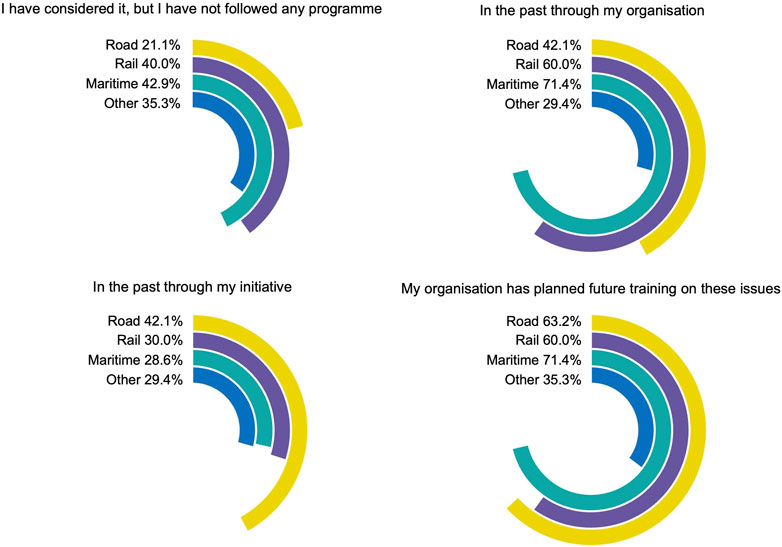
FIGURE 2. Percentage of respondents who have followed training programs on the automation/digitalization of their work environments by the sector.
Analyzing responses on training programs across gender also yields some interesting results: first, male respondents state that they have followed a training program in the past through their own initiative at a significantly higher percentage than female respondents (38.7% vs. 23.8%); second, women state that they have followed a program in the past through their organization to a markedly higher percent than men (38.1% vs. 25.8%), as shown in Figure 3.
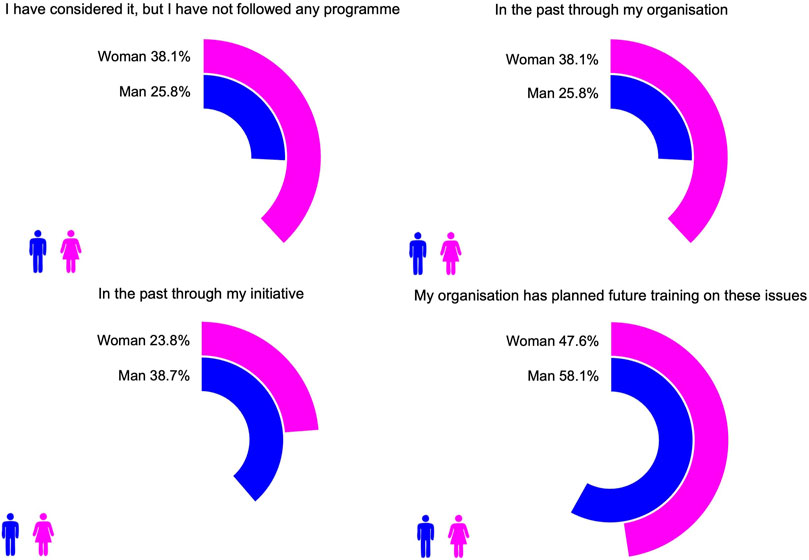
FIGURE 3. Percentage of respondents—by gender—who have followed training programs on the automation/digitalization of their work environments.
4.3.1 Automation issues arising
Figure 4 shows the level of agreement of respondents to the statement “I have experienced issues related to the digitalization of my work environment”. Nearly one-third of the participants (9.4% + 13.2% + 13.2% = 35.8%) have not experienced any issues. This is contrasted with about two-thirds of the respondents who agree with the statement (17.0% + 28.3% + 18.9% = 64.2%), implying that the ones responding in this way have experienced at least noticeable issues related to the digitalization of their work environment.
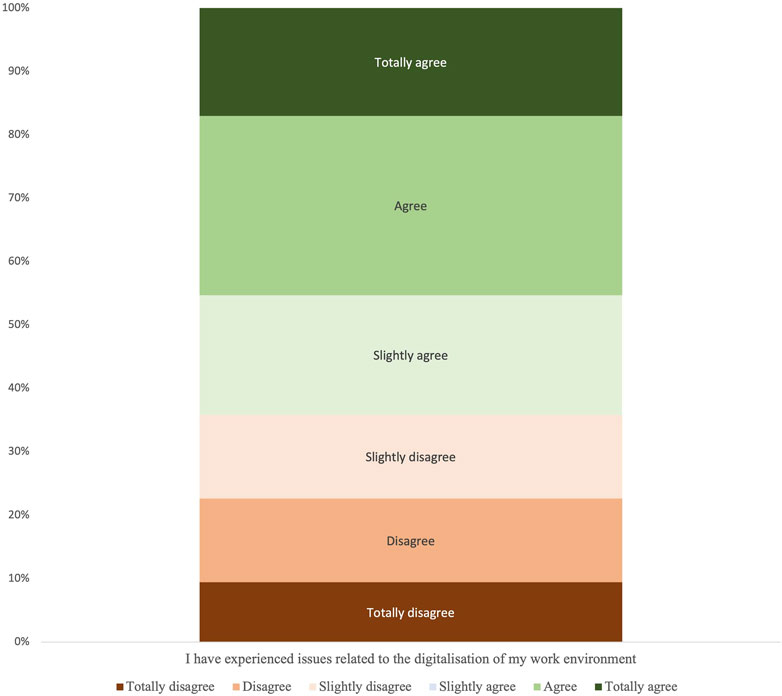
FIGURE 4. Level of agreement with the statement: “I have experienced issues related to the digitalisation of my work environment”.
By analyzing and comparing the outcomes of Figure 4 across the different sectors, it can be observed that “Rail” and “Other” sectors (including Air) have experienced the most issues. In the maritime sector, advanced autonomy, as defined per degrees III and IV in the IMO. (2022), is, at present, mainly an experimental proposition with some prototypes; in this sector, where digitalization has broken through quickly but also still in a rather limited way, more than 57% of the respondents disagree in principle that they have experienced any issues. This conclusion could be attributed to the low level of applied digitalization and advanced automation (autonomy in shipping); alternatively, it could also be associated with the results of Figure 4, as those whose organizations belong to the maritime sector seem to have received more job trainings than the others in view, eventually, of the quick inroads digitalization is making in some parts of the sector. Figure 5.
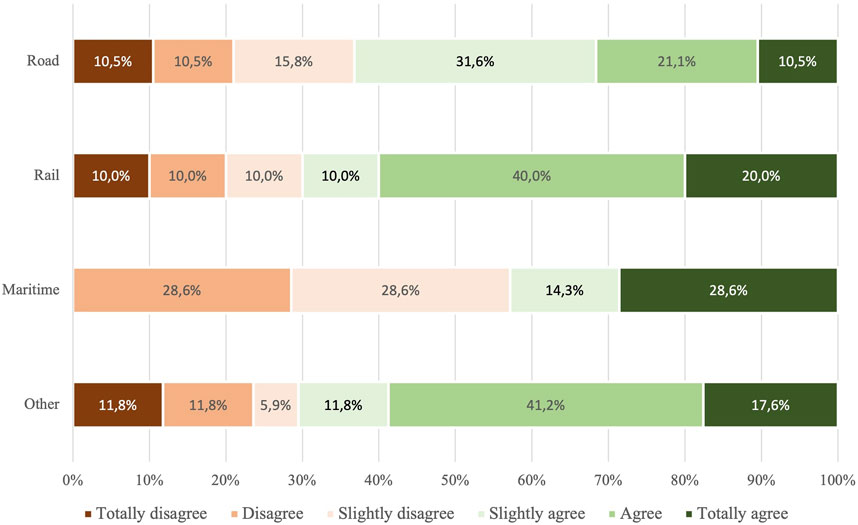
FIGURE 5. Sector level of agreement with the statement “I have experienced issues related to the digitalization of my work environment”.
4.3.2 Barriers and gaps
Respondents were requested to express their level of agreement with statements referring to potential barriers and gaps that could affect the workforce to fit in an automated and digitalized work environment. Specifically, the following statements were provided:
• Lack of expertise: Workers may not have the necessary knowledge or experience to use the new tools and technologies that are being introduced in automated and digitalized work environments.
• Inadequate training: Workers may not have access to the training or resources they need to develop the skills and knowledge required to work effectively in automated and digitalized work environments.
• Lack of specific legislation: There may be a lack of laws or regulations in place that address the changing nature of work in an automated and digitalized environment, which could lead to uncertainty or confusion for workers.
• Little information on automation/digitalization: Workers may not have access to clear and accurate information about the ways in which automation and digitalization are transforming the workplace, which could limit their ability to prepare for and adapt to these changes.
As shown in Figure 6, ca. 70% of respondents recognize the lack of expertise as a barrier/gap. Similarly, over 70% recognize inadequate training as a barrier/gap. The similarity of the two results points directly to the issue of skills through education/training. Another answer receiving a high level of agreement among respondents highlights the “not sufficient level of information provided to them on automation/digitalization” as a barrier/gap, confirming the previous result.
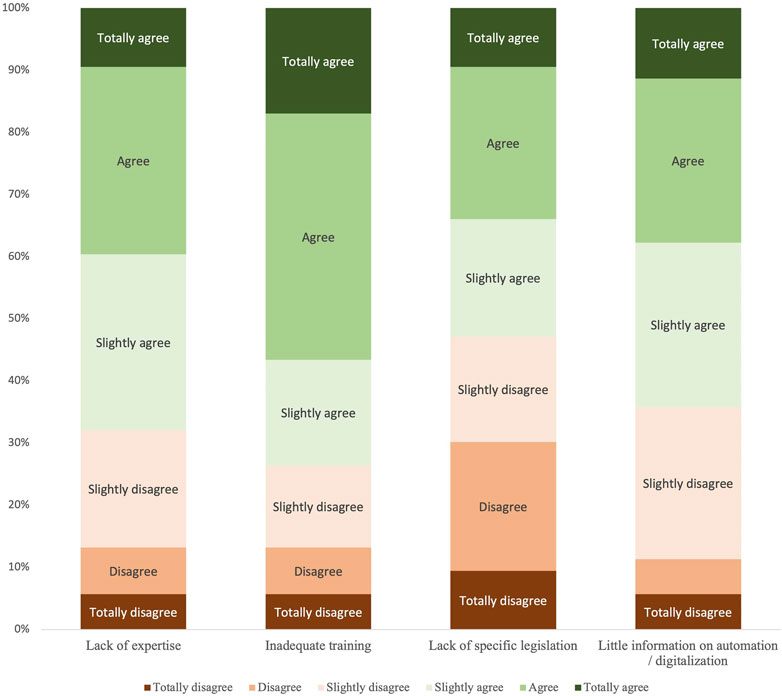
FIGURE 6. Level of agreement with statements referring to BARRIERS and GAPS that could affect the workforce to fit in an automated and digitalized work environment.
About half of the respondents point to the lack of legislation in the area of automation, but it is worth noting that almost 30% of the respondents totally disagree or disagree with the statement of lack of specific legislation. It is possible that the respondents who disagreed with the statement may feel that there is already sufficient legislation in place to address the challenges and opportunities presented by automation and digitalization in the workplace. Alternatively, they may believe that existing laws and regulations can be adapted or extended to cover these areas. On the other hand, those who agreed with the statement may feel that the pace of technological change is outstripping the ability of governments and regulators to keep up, and that new legislation is needed to ensure that workers’ rights and interests are protected.
Moreover, this question allowed the respondents to discover other barriers and gaps. Some of the answers given to the open-ended part of the question were practically identical, at least in meaning and direction. The answers are clustered in Table 4 by the main categories of barriers and gaps directly emerging: technological infrastructure gaps, organizational/management/regulatory barriers and gaps, demographic and skills’ gaps, and cultural barriers. Demographics and skills’ gaps have been amalgamated in the clustering as they are mutually compounded through time of service left available for reskilling of members of the workforce close to retirement and by lack of new skills among earlier trained workforce. Organizational/management/regulatory barriers and gaps have similarly been clustered together as some of the statements contributed imply lack of managerial agility and the creation of obstacles to the process—thus adding to not solving problems created for the workforce—while some others imply lack of adequate provision and have the characteristic of a gap more. In this latter case, the problem may well lay with the lack of adequate regulatory provisions, hence the related heading in the upper right quadrant of Table 4.
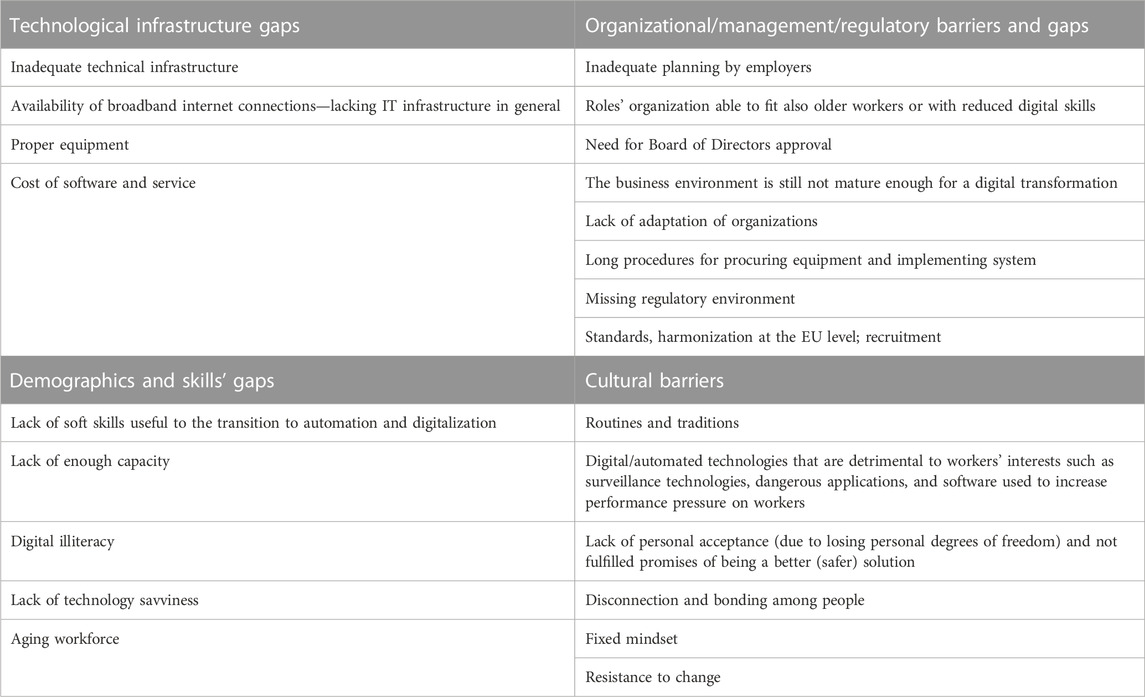
TABLE 4. Responses contributed to the open-ended section about potential barriers and gaps that could affect the workforce to fit in an automated and digitalized work environment.
4.3.3 Skills and competencies to meet the challenges of the future
Respondents were called to rate the level of importance for a given list of skills and competencies to meet the challenges of the future automated and digitalized work environment. The list of skills and competencies emerged from previous workshops are organized in the context of WET as a combination of various types of skills that are highly valued in today’s rapidly evolving and increasingly complex workplace and are as follows:
• Analytical thinking: The ability to break down complex information or problems into smaller components in order to understand them better and identify potential solutions.
• Innovation: The ability to generate new ideas or concepts that can drive progress, growth, and change within an organization or industry.
• Emotional intelligence: The capacity to identify, understand, and manage one’s own emotions and recognize and respond effectively to the emotions of others.
• Creativity: The ability to think outside the box, develop new and original ideas, and approach problems in novel ways.
• Originality: The ability to develop ideas or solutions that are unique or distinctive, often by combining or adapting existing concepts in new and innovative ways.
• Initiative: The willingness and ability to take action or make decisions independently, without waiting for direction from others.
• Critical thinking: The ability to objectively analyze and evaluate information in order to form well-reasoned judgments or make informed decisions.
• Persuasion: The ability to communicate effectively and influence others in order to achieve desired outcomes or objectives.
• Negotiation: The ability to engage in a give-and-take process with others to reach mutually beneficial agreements or solutions.
• Information and Communication Technology (ICT) skills: The ability to use various technologies, including hardware, software, and applications, to perform tasks and solve problems.
• Science, Technology, Engineering, and Mathematics (STEM) skills: The skills and knowledge in the fields of science, technology, engineering, and mathematics, which are highly valued in many industries and sectors, especially those related to technology, innovation, and research.
According to Figure 7, the most important is the Information and Communication Technology (ICT) skillset and Analytical thinking. From the opposite side, Persuasion skills and competence for Negotiation were rated as the least important, with Originality following. This result is quite in the mainstream, with the notable exclusion of innovative companies asking for profiles able to express creativity and emotional skills:
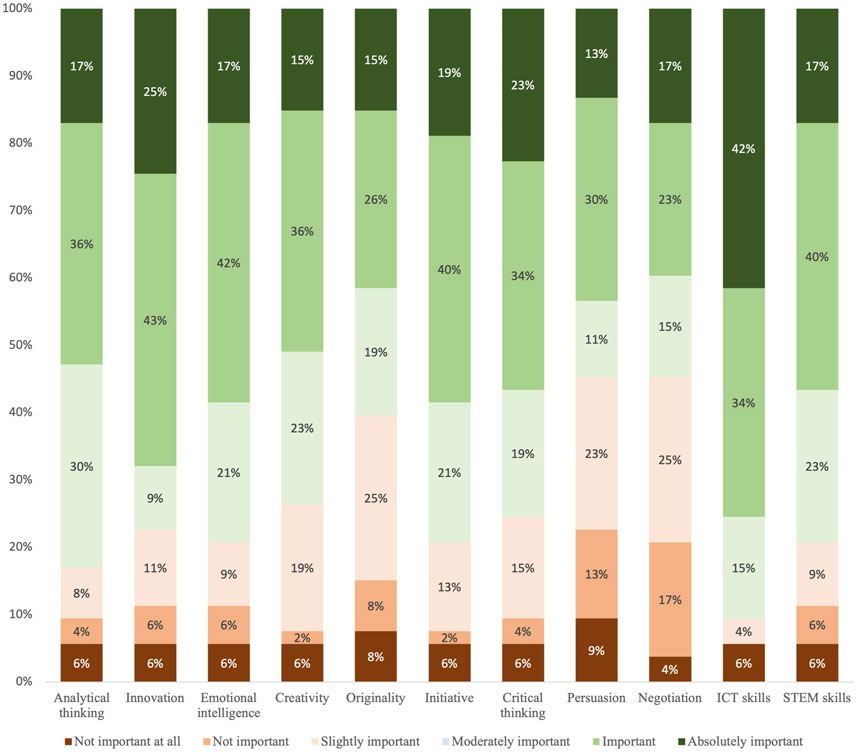
FIGURE 7. Level of importance of different SKILLS and COMPETENCIES to meet the challenges of the future automated and digitalized work environments.
4.3.4 Opportunities that could be created through automation
Similar to as described previously, respondents were called to rate the level of importance of the opportunities that could be created by future automated and digitalized work environments. The considered list of opportunities is the following:
• Rising salaries: As automated and digitalized work environments become more prevalent, there may be opportunities for workers to take on more high-skilled and high-paying roles that involve designing, developing, or managing these systems.
• Support to the aging workforce to stay in place: With the help of automation and digitalization, older workers may be able to continue working in physically demanding roles for longer periods of time, as these tasks could be partially or fully automated.
• Upskilling of the workforce: As automation and digitalization change the nature of work, there may be opportunities for workers to acquire new skills and transition to higher-skilled roles that involve working with or managing these systems.
• Creation of automation-related jobs: As organizations adopt automation and digitalization, there may be new opportunities for workers to design, develop, implement, and maintain these systems, creating new job opportunities.
• Decreasing amounts of unpaid labor in the global workforce: As automation and digitalization make certain tasks more efficient and less labor-intensive, there may be a shift toward reducing unpaid labor, particularly in the domestic sphere, freeing up time for workers to pursue paid employment or other activities.
Based on Figure 8, respondents believe that the upskilling of the workforce is of the highest importance. The creation of automation-related jobs is rated very important, similar to the upskilling of the workforce, by almost nine out of the 10 participants in the survey. The results with regard to this part of the question not only present a symmetry in importance/non-importance terms but also in importance intensity terms, which requires further analysis in subsequent studies. Alternatively, their interpretation could be based on the possibility that perceptions are highly subjective owing to the lack of sufficient known evidence by respondents on the potential of automation in that direction.
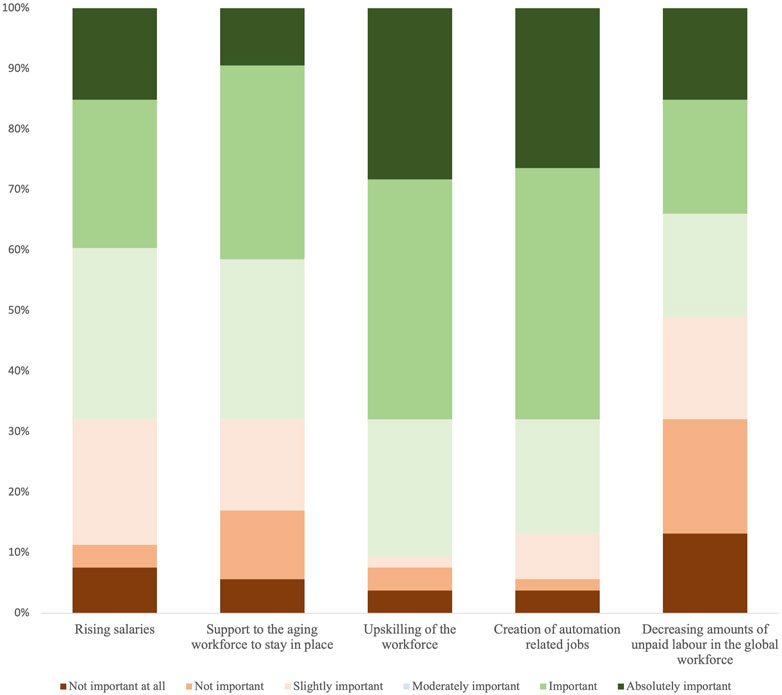
FIGURE 8. Level of importance of each of OPPORTUNITIES that could be created by future automated and digitalized work environments.
Based on the results presented in Figure 8, a comparative analysis was conducted to compare the responses of various transport modes by the sector. The most significant finding was that all respondents (100%) in the Maritime and “Other” sectors expressed that the opportunity of “Upskilling of the workforce” was at least moderately important. This was in contrast to the rail and road sectors, where the respective percentages were 90% and 79.0%, Figure 9.
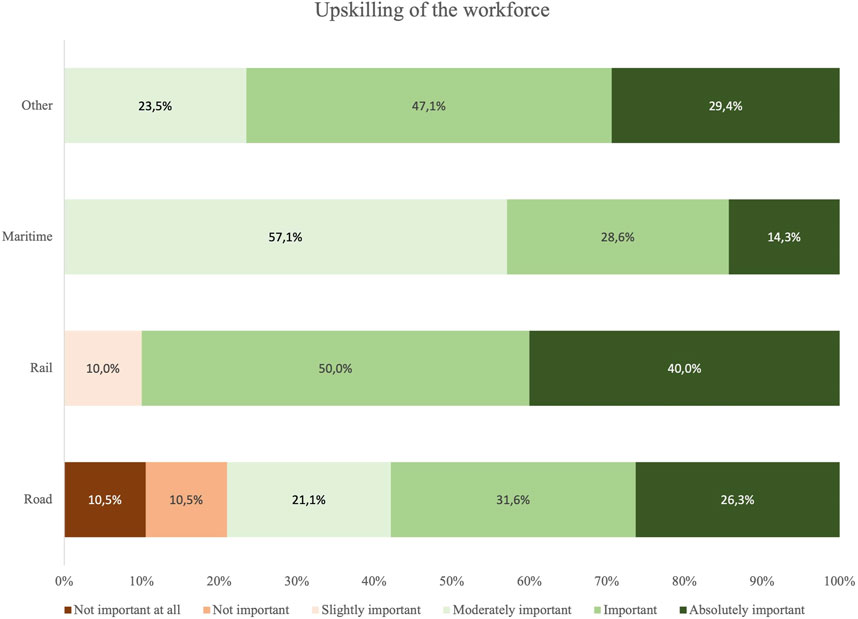
FIGURE 9. Level of importance for the opportunity of “upskilling of the workforce” per transport sector.
Moreover, respondents reported other opportunities in the open-ended part of the question, as shown in Table 5. Analytically, there were at least two responses denoting that not only no opportunity could be found but also negative impacts could be added such as
• less interactive work sessions among employees;
• increasing amount of unpaid work hours and higher efficiency gains (pressure on workforce).
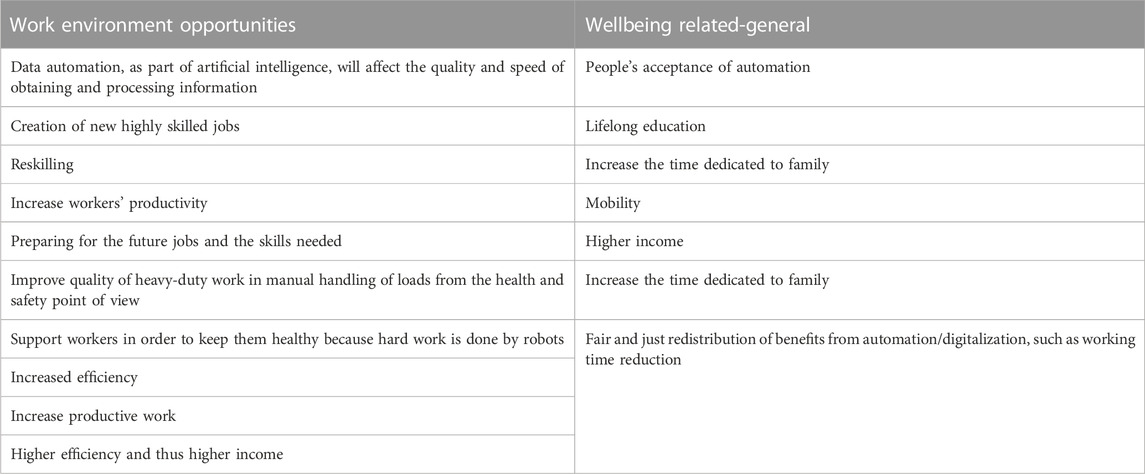
TABLE 5. Responses contributed to the open-ended section about the OPPORTUNITIES that could be created by future automated and digitalized work environments.
Another respondent referred to the need for budget allowance, eventually as a prerequisite for opportunity creation.
Table 5 classifies open-ended responses provided on automation-related opportunities in two categories:
• opportunities related to work and the work environment;
• opportunities related to general wellbeing.
It is noted that the aforementioned results should be treated with caution as the study involves a relatively small number of respondents. However, the analysis clearly demonstrates trends and opinions of key decision-makers which reveal key dimensions of the impact of automation on the workforce of different transport sectors.
5 Conclusion on barriers, gaps, opportunities, and success and failure factors of transport automation on the labor force and related recommendations
5.1 Main conclusion of the research
While automation and digitalization are constantly evolving along with their repercussions on society and more specifically on the workforce (Plattfaut and Borghoff, 2022), research maturity and publications are inevitably lagging on a fast proceeding transport and shipping transformation. Through the project’s participatory assessment and research activities, a large and quite representative audience from stakeholders across the transport and shipping value chains—from the employee and employer side and from the private, private–public, and public sectors—along with stakeholder representative organizations was probed through a variety of methods.
Another interesting aspect emerging from the research is that challenges do not concern all categories among the workforce—or even within other stakeholders—in the same way. Challenges related to loss of jobs and related repercussions are bound to affect groups within the workforce, which may be as follows:
• constrained by regulatory age limits to complete their upskilling or reskilling in time to assume a new or enhanced role;
• vulnerable if in part-time employment without access to retraining; this may be the case of workforce members near retirement or women in part-time employment constrained by additional family obligations.
Additionally, challenges related to working conditions also affect the remaining active workforce, while the decline of transport and shipping attractiveness impacts the potential workforce, which may opt-out of this career path, if challenges due to automation and digitalization increase uncertainty in terms of employment prospects in the transport and shipping sectors.
While barriers and gaps are the priority areas creating challenges, skills are by themselves a gap’s remedy and a challenge in terms of their urgency. While some opportunities may be partly compensating negative impacts, any list of challenges should be expected to be longer.
On the one hand, the clusters of barriers and gaps in the transportation industry demonstrate the complexity and challenges of the ongoing technological and social changes. The cultural barriers are related to workforce perceptions, resistance to change, and difficulty in creating effective teams. Educational barriers reflect the lack of competencies of workers, inadequate digitization-related training, and poor knowledge of new automated systems. Demographic barriers, such as the digital education gap, affect older people’s ability to adapt to new technologies. Technological barriers include risks related to automated vehicles and cybersecurity, as well as discomfort among customers and operators due to technology not working initially. Economic barriers are related to the incompatibility of investments with digitalization, increased insurance, and protection of workers’ liability. Structural–regulatory barriers reflect bureaucracy and high segregation of small enterprises. The gaps in ethics/regulation, economic issues, and meaningful work and achievement reflect the need for states to govern the changes, allocate resources to ensure minimum services, and redesign working spaces to fit new technologies.
On the other hand, the identified success factors for the transportation industry’s ongoing technological and social changes reflect the need for continuous learning, cultural change, and making technology understandable for any level in the company. Rebuilding local environments, financial incentives for reskilling/upskilling, and successful and meaningful training programs are also essential. A robust Train-the-Trainers program, good prior communication of the training’s scope, appropriate formulation of employee teams, tailored training programs, and creative reflection on job tasks are all critical elements. Job rotation, where applicable, can also help employees develop diverse skills and knowledge. Conversely, failure factors include anachronistic training material and not providing horizontal trainings, which can lead to employees’ inability to adapt to new technologies and processes. Overall, successful and meaningful training programs that are well-tailored to the needs of employees and provide continuous learning opportunities are crucial for ensuring the successful implementation of technological and social changes in the transportation industry.
5.2 Recommendations to the transportation industry and further research directions
A number of recommendations that could be proven beneficial to the transportation industry emerging from the analysis of all three approaches used in the research are as follows:
1. Upskilling and reskilling of the workforce: With the rapid advancement of technology in the transport industry, it is essential to upskill and reskill the existing workforce. Companies should offer training programs to help employees adapt to the new technologies and acquire new skills that are in high demand.
2. Collaboration with academia: Companies can partner with universities and other educational institutions to develop curricula and training programs tailored to the transport industry’s needs. This can help ensure that the next generation of workers is equipped with the necessary skills to meet the demands of the industry (Nathanail et al., 2020).
3. Address the digital divide: While digitalization offers many benefits, it can also exacerbate the digital divide, where some workers may be left behind due to a lack of access to digital technology. Companies should invest in bridging this gap and ensuring that all employees have access to the necessary tools and resources.
4. Collaboration between industry and government: The transport industry should work closely with governments to develop policies that support the workforce during the transition to automation and digitalization. This includes policies that promote training and upskilling, as well as policies that support workers who may be displaced due to automation.
5. Embrace diversity and inclusion: The transport industry should promote diversity and inclusion in the workforce to ensure that all workers have equal access to training and career opportunities. This includes promoting gender equality and providing opportunities for underrepresented groups in the industry.
6. Employee wellbeing: Automation and digitalization can increase workers’ stress and anxiety. Companies should prioritize employee wellbeing and provide resources such as counseling services and work–life balance programs to help workers cope with the changes.
7. Job redesign: As some jobs become automated, companies should consider redesigning jobs to make them more fulfilling and challenging for workers. This can include offering more opportunities for creativity and innovation, as well as opportunities for career advancement.
5.3 Limitations and further research
A major limitation of the study is the relatively small sample of respondents, as stated previously in the body of the paper. Another limitation is the unbalanced sample toward Managers as an occupation (66%) and Management Team as respondents’ current position in their organization (58.2%). Both limitations increase the margin of error and apply a managerial lens when trying to interpret the results. While managers are capable of getting a good grasp on how automation and digitalization will affect the workforce at a high level, workers, staff and crew, academicians, and others are the final pieces of automation’s ordinary effect puzzle.
Further research is planned to formulate a comprehensive, evidence-based, action-oriented, appropriate plan to tackle the identified challenges. This agenda does not only seek solely to connect the identified workforce challenges with targets, goals, and directions but also to demonstrate connections with a) targeted stakeholders: enterprises, workforce, and trade unions; b) technology trends and drivers; c) implementation actions; d) monitoring methods and actions; e) roles and responsibilities; g) key milestones and time-horizons. All these aspects will emerge from an in-depth analysis of eight different Thematic Areas (TAs) shedding light on issues such as Governance of transition, the Role of local and regional authorities, Platforms for gig workers, and Regulation of transition in the view of collective bargaining. The next steps of the data sourcing and validation processes in the context of the WET line of research are planned as to allow balancing probing the stakeholder wider survey audience further.
Data availability statement
The raw data supporting the conclusion of this article will be made available by the authors, without undue reservation.
Ethics statement
Ethical review and approval were not required for the study on human participants in accordance with the local legislation and institutional requirements. The patients/participants provided their written informed consent to participate in this study.
Author contributions
All authors listed have made a substantial, direct, and intellectual contribution to the work and approved it for publication.
Funding
This work has been supported by the WE-TRANSFORM project (https://wetransform-project.eu/) and has been funded within the EC H2020 Research and Innovation Program (Grant Agreement No. 101006900).
Acknowledgments
The authors would like to acknowledge the reviewers for their valuable guidance and helpful comments.
Conflict of interest
The authors declare that the research was conducted in the absence of any commercial or financial relationships that could be construed as a potential conflict of interest.
Publisher’s note
All claims expressed in this article are solely those of the authors and do not necessarily represent those of their affiliated organizations, or those of the publisher, the editors, and the reviewers. Any product that may be evaluated in this article, or claim that may be made by its manufacturer, is not guaranteed or endorsed by the publisher.
Supplementary Material
The Supplementary Material for this article can be found online at: https://www.frontiersin.org/articles/10.3389/ffutr.2023.1173657/full#supplementary-material
Supplementary Data Sheet S1 | Questionnaire on barriers, gaps, skills, opportunities, benchmarks, driving forces, and positive/negative effects of transport automation on the labour force.
References
Abate, M., Christidis, P., and Purwanto, A. J. (2020). Government support to airlines in the aftermath of the COVID-19 pandemic. J. Air Transp. Manag. 89, 101931. doi:10.1016/j.jairtraman.2020.101931
Agrawal, S., Schuster, A. M., Britt, N., Mack, E., Tidwell, M., and Cotten, S. (2023). Building on the past to help prepare the workforce for the future with automated vehicles: A systematic review of automated passenger vehicle deployment timelines,. Technol. Soc. 72, 102186–102791. doi:10.1016/j.techsoc.2022.102186
Chinoracký, R., and Čorejová, T. (2019). Impact of digital technologies on labor market and the transport sector. Transp. Res. Procedia 40, 994–1001. doi:10.1016/j.trpro.2019.07.139
Christidis, P., Navajas Cawood, E., Brons, M., Schade, B., and Soria, A. (2014). Future employment in transport: Analysis of labour supply and demand, JRC research reports JRC93302, joint research centre (seville site). JRC Research Reports JRC93302.
Coombs, C., Hislop, D., Taneva, S., and Barnard, S. (2020). The strategic impacts of Intelligent Automation for knowledge and service work: An interdisciplinary review,. J. Strategic Inf. Syst. 29, 101600–108687. doi:10.1016/j.jsis.2020.101600
Deloitte (2021). Reshoring or localization on your mind? 16 september 2021. Available at: https://www2.deloitte.com/us/en/insights/topics/operations/reshoring-supply-chain.html.
Dyllick, T., and Muff, K. (2016). Clarifying the meaning of sustainable business: Introducing a typology from business-as-usual to true business sustainability. Organization and Environment. 2016 29 (2), 156–174. doi:10.1177/1086026615575176
Frey, C. B., and Osborne, M. (2017). The future of employment: How susceptible are jobs to computerisation? Technol. Forecast. Soc. Chang. 2017 (114), 254–280. doi:10.1016/j.techfore.2016.08.019
Ghasri, M., and Maghrebi, M. (2021). Factors affecting unmanned aerial vehicles’ safety: A post-occurrence exploratory data analysis of drones’ accidents and incidents in Australia. Saf. Sci. 2021 (139), 105273. doi:10.1016/j.ssci.2021.105273
Goos, M. (2018). The impact of technological progress on labour markets: Policy challenges. Oxf. Rev. Econ. policy 34 (3), 362–375. doi:10.1093/oxrep/gry002
ICS (2022). Press release 24/2/2022. Available at https://www.ics-shipping.org/press-release/russian-and-ukrainian-seafarers-make-up-14-5-of-global-shipping-workforce-according-to-ics/.
ILO (2020). Guidelines on the promotion of decent work and road safety in the transport sector. Available at: https://www.ilo.org/wcmsp5/groups/public/–-ed_dialogue/–-sector/documents/normativeinstrument/wcms_742633.pdf.
IMO (2022). “(2021). Outcome of the regulatory scoping exercise for the use of maritime autonomous surface ships (MASS). MSC.1/Circ.1638, 3 June 2021,” in Globalisation, new and emerging technologies, and sustainable development (London, United Kingdom: Routledge), 189–207. Available at: https://wwwcdn.imo.org/localresources/en/MediaCentre/HotTopics/Documents/MSC.1-Circ.1638%20-%20Outcome%20Of%20The%20Regulatory%20Scoping%20ExerciseFor%20The%20Use%20Of%20Maritime%20Autonomous%20Surface%20Ships.%20(Secretariat).pdf.
IPA (Infrastructure Partnership Australia) (2017). Automated Vehicles: Do we know which road to take? Available at: https://infrastructure.org.au/wp-content/uploads/2017/09/AV-paper-FINAL.pdf.
Keller, A., and Krašna, S. (2023). Accelerations of public transport vehicles: A method to derive representative generic pulses for passenger safety testing. Front. Future Transp. 4, 931780. doi:10.3389/ffutr.2023.931780
Maung, Y. S. Y., Douglas, I., and Tan, D. (2022). Identifying the drivers of profitable airline growth. Transp. Policy 115, 275–285. doi:10.1016/j.tranpol.2021.11.007
Muller, P. J. (2007). “A personal rapid transit/airport automated people mover comparison,” in In aviation: A world of growth (England, WV: PRT Consulting, Inc.).
Nathanail, E., Adamos, G., Mitropoulos, L., Karakikes, I., and Yatskiv, I. (2020). How efficiently educational programs prepare professionals to meet current and future challenges of transport interchanges. Eur. Transp. Transporti Europei 79 (10), 1–23. doi:10.48295/et.2020.79.10
OECD (2023). Data in an evolving technological landscape: The case of connected and automated vehicles. Available at: https://one.oecd.org/document/DSTI/CDEP/GD(2022)3/FINAL/en/pdf.
Plattfaut, R., and Borghoff, V. (2022). Robotic process automation: A literature-based research agenda. J. Manag. Inf. Syst. 36 (2), 173–191. doi:10.2308/ISYS-2020-033
Polydoropoulou, A., Thanopoulou, H., Karakikes, I., Pronello, C., and Tyrinopoulos, Y. (2023). “Exploring the effects of transport automation and digitalization on the labor force: Insights from stakeholders across all transport sectors,” in 2nd annual meeting of TRB (Washington, D.C: TRB).
Salon, D., Mirtich, L., Bhagat-Conway, M. W., Costello, A., Rahimi, E., Mohammadian, A. K., et al. (2022). Wigginton Bhagat-Conway, M., Costello, A., Rahimi, E., Mohammadian, A., Chauhan, R.S., Derrible, S., da Silva Baker, D., Pendyala, R., The COVID-19 pandemic and the future of telecommuting in the United States, Transportation Research Part D:. Transport and Environment 112, 103473. doi:10.1016/j.trd.2022.103473
Shiftan, Y., and Wilson, N. (1994). Absence, overtime, and reliability relationships in transit workforce planning. Transportation Research Part A Policy and Practice 28, 245–258. doi:10.1016/0965-8564(94)90020-5
Steimle, L., Sun, Y., Johnson, L., Besedeš, T., Mokhtarian, P., and Nazzal, D. (2022). Students’ preferences for returning to colleges and universities during the COVID-19 pandemic: A discrete choice experiment. Socio-Economic Planning Sciences 82, 101266. doi:10.1016/j.seps.2022.101266
Thanopoulou, H., and Strandenes, S. P. (2021). “Consequence based risk management in shipping: The ArRC approach,” in Paper presented at the IAME 2021 conference (Rotterdam: IAME).
Tsouros, I., Tsirimpa, A., Pagoni, I., and Polydoropoulou, A. (2021). Activities, time-use and mental health during the first COVID-19 pandemic wave: Insight from Greece. Transportation Research Interdisciplinary Perspectives 2021 (11), 100442. doi:10.1016/j.trip.2021.100442
UK Parliament (2018). Automated and electric vehicles bill. Available at: https://publications.parliament.uk/pa/bills/lbill/2017-2019/0082/18082en.pdf.
United Nations (2019). Global sustainable development report 2019 the future is now: Science for achieving sustainable development. Available at: https://sdgs.un.org/gsdr/gsdr2019.
Vermeulen, B., Kesselhut, J., Pyka, A., and Saviotti, P. P. (2018). The impact of automation on employment: Just the usual structural change. Sustainability 2018 10 (5), 1661. doi:10.3390/su10051661
WE-TRANSFORM (2022). Deliverable D3.1. Report of actions and initiatives related to transport automation and other transitions. Available at: https://www.wetransform-project.eu/site/assets/files/1724/wet_d3_1_220415_report_of_actions_and_initiatives_related_to_transport_automation_and_other_transitions.pdf.
World Bank (2020). Tackling the impact of job displacement through public policies. Available at: https://www.worldbank.org/en/news/feature/2020/10/20/tackling-the-impact-of-job-displacement-through-public-policies.
Keywords: automation, workforce, skills, participatory approach, collective intelligence, sustainable transport
Citation: Polydoropoulou A, Thanopoulou H, Karakikes I, Pronello C and Tyrinopoulos Y (2023) Adapting to the future: examining the impact of transport automation and digitalization on the labor force through the perspectives of stakeholders in all transport sectors. Front. Future Transp. 4:1173657. doi: 10.3389/ffutr.2023.1173657
Received: 13 March 2023; Accepted: 05 June 2023;
Published: 29 June 2023.
Edited by:
Aoyong Li, Tsinghua University, ChinaReviewed by:
Anna Cierniak-Emerych, Wroclaw University of Economics, PolandYang Fei, Tsinghua University, China
Copyright © 2023 Polydoropoulou, Thanopoulou, Karakikes, Pronello and Tyrinopoulos. This is an open-access article distributed under the terms of the Creative Commons Attribution License (CC BY). The use, distribution or reproduction in other forums is permitted, provided the original author(s) and the copyright owner(s) are credited and that the original publication in this journal is cited, in accordance with accepted academic practice. No use, distribution or reproduction is permitted which does not comply with these terms.
*Correspondence: Ioannis Karakikes, aWthcmFraWtlc0BhZWdlYW4uZ3I=
 Amalia Polydoropoulou
Amalia Polydoropoulou Helen Thanopoulou1
Helen Thanopoulou1 Ioannis Karakikes
Ioannis Karakikes